Resistance Report: Deocha-Pachami Coal Mine Project/ Tanmay Das; Malay Tewari/ Issue 06
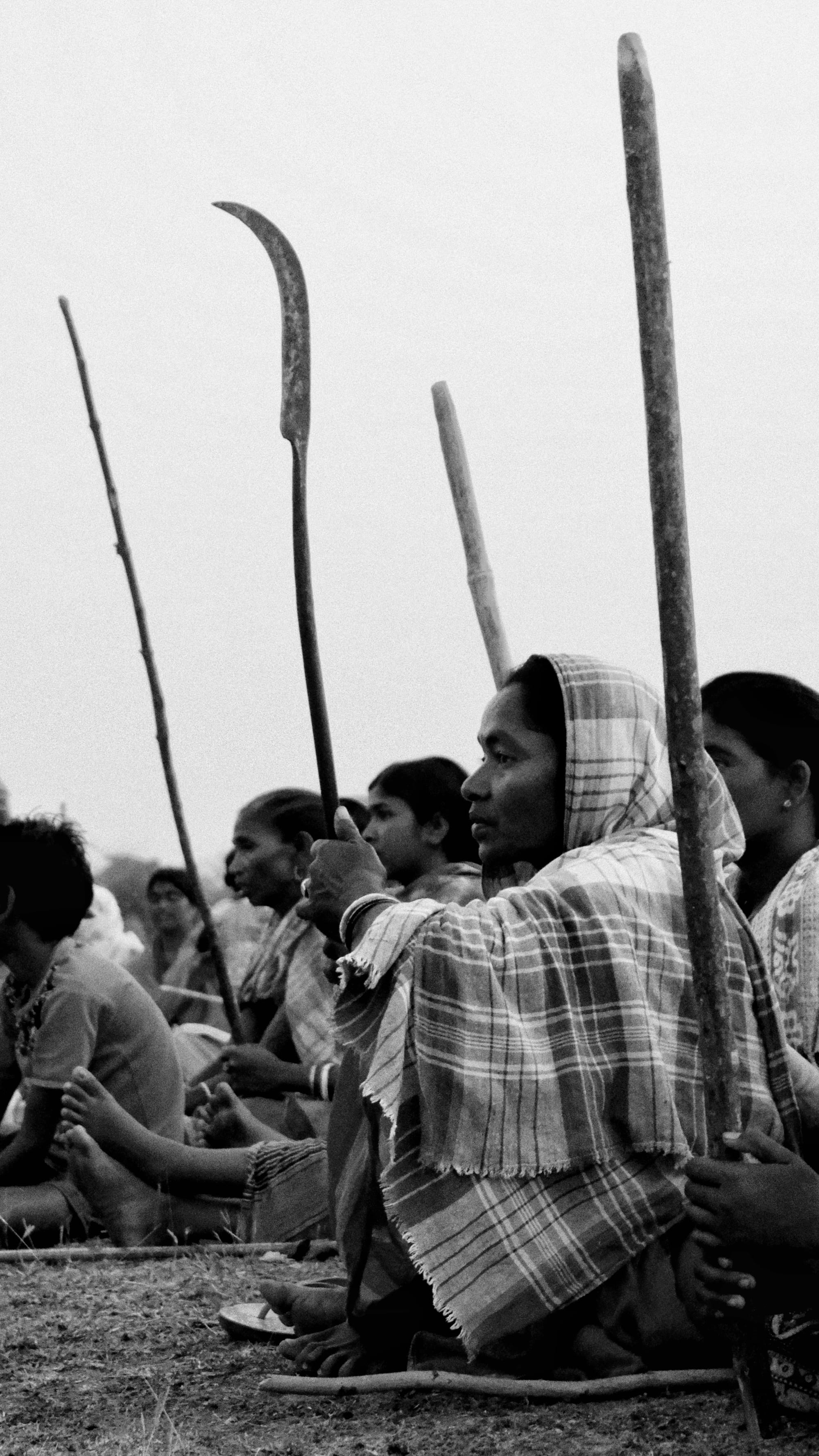
Photography by Tanmay Das
Text by Malay Tewari
The West Bengal government has announced a huge open cast coal mining project in the Mohammad Bazar Block of Birbhum district. The name of the project is Deocha-Pachami-Dewanganj-Harinsinga Coal Block or DPDH project. The project has already met stiff resistance from local villagers and alarming concerns have been raised about the far reaching social and environmental impacts of the open cast project (OCP). Political parties like CPI(ML) Liberation, CPI(M) and Swaraj India have expressed opposition to the project, calling it a catastrophe, and are taking steps to build public opinion in solidarity with the villagers’ movement. The villagers are carrying out resistance-movement forming ‘Birbhum Jami Jeevan Jibika O Prakriti Bachao Mahasabha.’ Santhal women are in the front row of this resistance.
There will be a 1 km deep open pit over an area of 12 sq. km. A total of 19 villages of ten mouzas will be lost in this mine cavity. 21 thousand people from 4314 families will be evicted. Most of them are indigenous people of Santhal society, and there are people from the Dalit and minority communities. This area is the area of Santhal Hul. It was the Santhal farmers who first settled here. Again, there are many Santhal families who have been evicted from some other development projects and had settled here a couple of generations ago. All of these people will be thrown into a vacuum in the name of rehabilitation.
The government has not conducted any survey on the social impact of this project. But the experience of so-called rehabilitation across the country is plenty before us. Sociologists have identified the conditions of project affected people after eviction in development projects and the subsequent so-called maximum rehabilitation and compensation as: landlessness, unemployment, homelessness, marginalization, food insecurity, increase in mortality and morbidity, loss of social property and shared property. The Deocha-Pachami families, no matter what the cost of compensation, will never get back the land they lost. The sudden arrival of raw money will not pave the way for any permanent income, but will give rise to mutual distrust. The attachment, self-identity and dependence that was born with the area has to be lost and thrown away. Jaher Than or the graves of loved ones, the place of rejoicing or the beautiful place of living built by one’s own hands, the cultural-historical-natural environment— taking everything away and throwing it into a desolate dying void without minimum social capital is called ‘rehabilitation’!
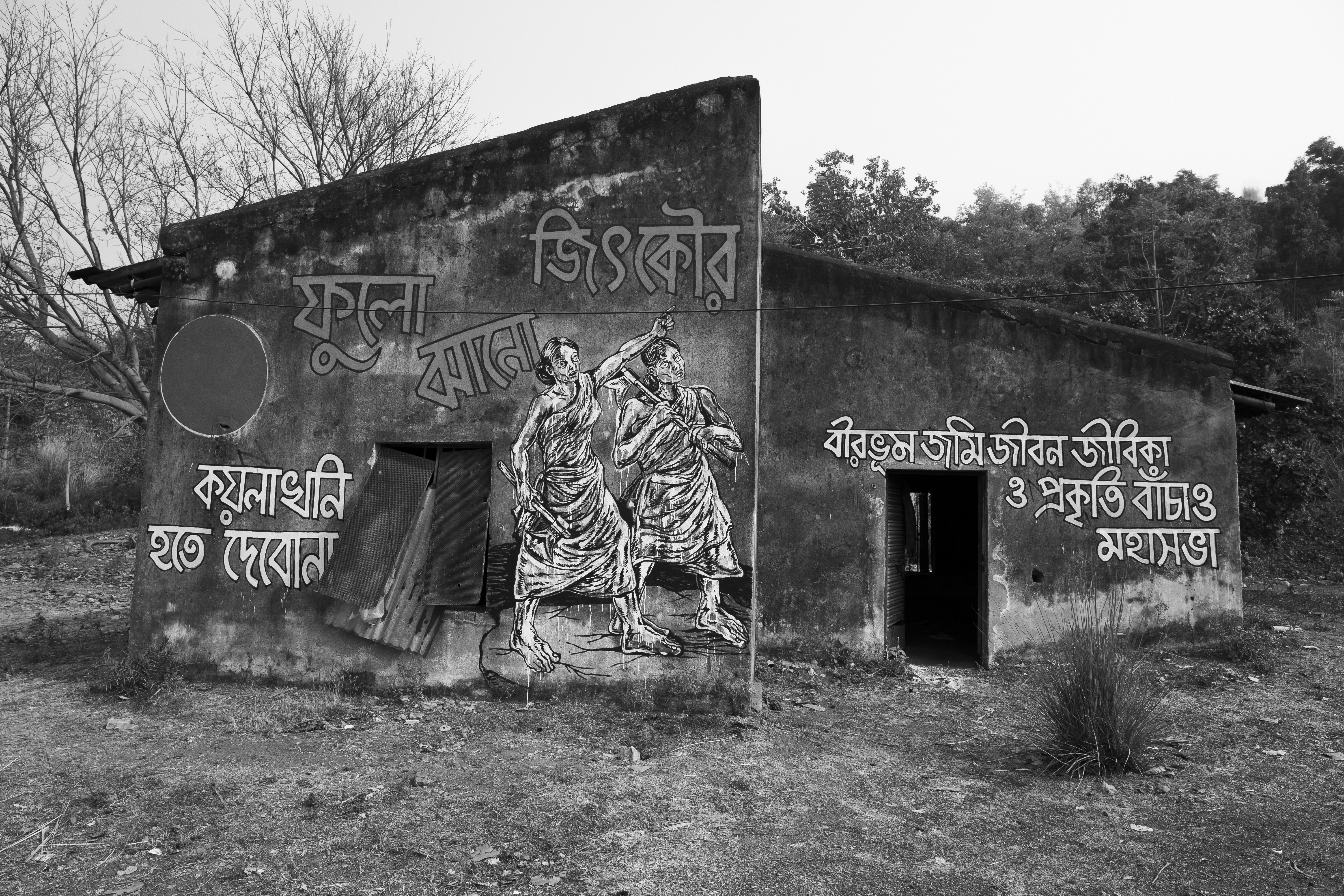
Written on the walls: We Will Resist the Coal Mines
The project area is surrounded on three sides by many large densely populated villages. The river Dwarka flows through here. On this river, near the proposed project is the Deocha reservoir. Nearby are the Tilpara and Massanjore reservoirs on the Mayurakshi river. Several warm springs including Bakreshwar and Paniphala are related to the topography of this area. The massive excavation of DPDH will affect all these things in many ways. Massive explosions, earthquakes, day and night mechanical noises, huge mounds of waste all around, pollutant particles scattered in the water and air, draw-down of the groundwater table, severe water crisis and an inevitable mafia-raj will disrupt public life in and around. Acid drainage will have far-reaching damage to the district’s agriculture and with heavy metallic particle coatings at the bottom of reservoirs endangering aquaculture.

Written on the walls: Coal Mine Go Back
The Chief Minister has repeatedly claimed that the Deocha-Pachami coal mine project is a government project. This is also a deception. The government agency for coal extraction is not involved in this project. The project is being implemented through WBPDCL (West Bengal Power Development Corporation Limited), a West Bengal government agency. But WBPDCL is a power generation company, not a mining company. Needless to say, the mine will actually go to a corporate company under the auspices of this government agency. More specifically, in the hands of Adani Group. (Just like in the Parsa coal block in Hasdeo Arand of Chhattisgarh.) The area has been handed over to Adani Group with the power generation company of Madhya Pradesh in the forefront. The mine will destroy large numbers of indigenous peoples and destroy India’s deepest and most biodiverse forests. Indigenous resistance has continued for more than ten years now. All the Gram Sabhas have taken a stand against mining. Ignoring all that, the BJP government allowed the excavations last May and launched a massive attack on the tribals with police and thugs. The government– corporate association is not an isolated incident, then. Recently, the National Thermal Power Corporation (NTPC) has awarded tenders to Adani Group to import coal worth Rs 6,585 crore. The Modi government first gave our bank money to the Adani Company to acquire coal mines in Australia, and now the government agency NTPC will pay Adani huge sums to buy that coal at exorbitant prices. Meanwhile, the Modi government is handing over our country’s ports, railways, roads and power supply lines to the Adanis in the name of monetization. Under these circumstances, the Adani empire is spreading its grip in West Bengal. Adani is taking over the proposed deep sea port of Tajpur and the Haldia port. They are also looking for the agriculture sector of Bengal, too, buying rice mills from East Burdwan.
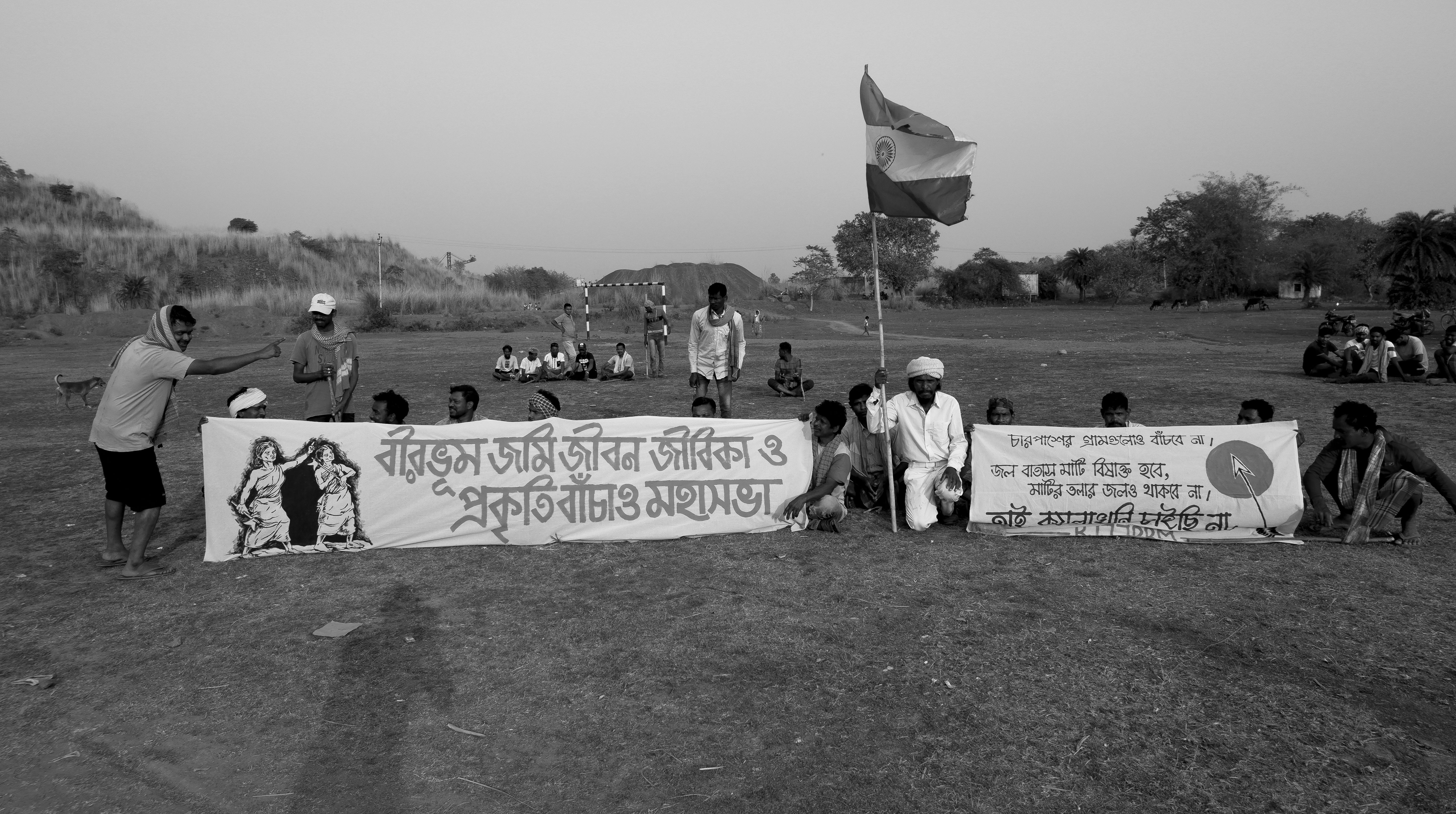
Villagers gathering gradually at the site of sit-in protest, Dharna Manch
Locals have been protesting since the project was announced. A demonstration took place last November. The ruling party immediately became active and sought to quell the protests by employing one of the most influential tribal leaders in the area. During this time a delegation of CPI(ML) Liberation met the villagers and collected public opinion. Several other fact finding teams were sent from different civil rights and social organizations such as Association for Protection of Democratic Rights (APDR) and Bharat Jakat Majhi Pargana Mahal. It was clear from the reports of all these observer groups that in general the villagers were opposing the DPDH coal project and the police, administration and ruling party had always kept a close watch on them. The government and the corporate media started promoting loudly that the local people were happy with the rehabilitation package and gladly handed over the land. But news of the protests surfaced again in December. Protests were organized in a village against the proposed project. Police sued the organizers of the procession using Covid related DM act and then the ruling TMC entered the village with a procession led by their Adivasi leader in support of mining. This procession of the ruling party faced the siege of the women of the village. The police force lathi charged. At least 25 women were injured. The foetus of a woman named Mainamati Soren was killed. CPI(ML) Liberation and APDR promptly organised protest demonstrations in Kolkata and other cities against this atrocity. CPI(ML) Liberation, Swaraj India, Young Bengal and Uthnou jointly organised a mass deputation to the Birbhum DM, and a joint support team from various organizations visited the DPDH area in January. A platform comprising various students, youth, women organisations, trade unions and human rights organisations jointly organised a convention in Kolkata demanding the DPDH project to be scrapped.
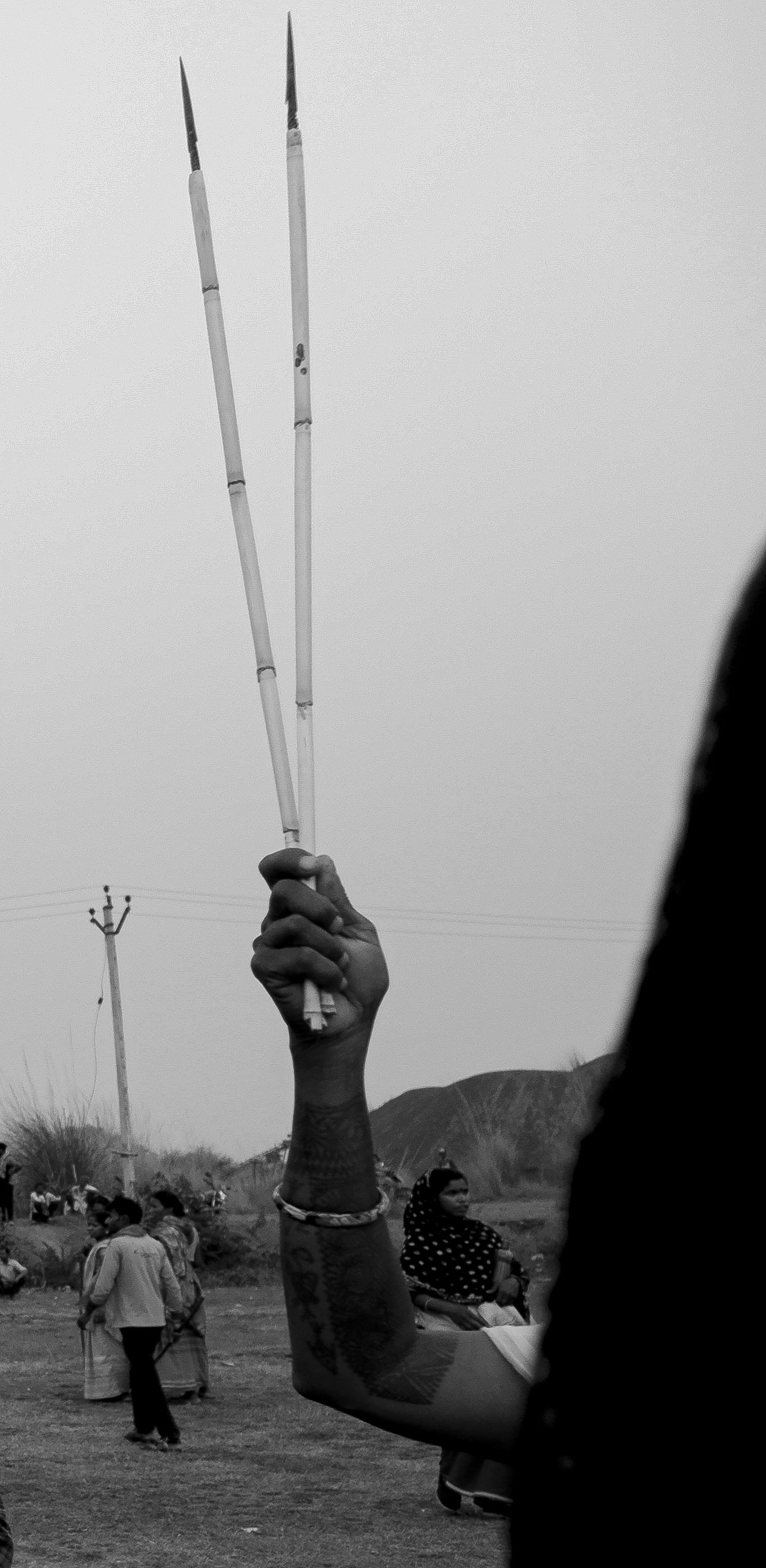
Traditional weapons, which have been historically a part of the culture of the indigenous people, are carried during protests
As stated above, in November-December FFT from various Left parties, mass organizations and Adivasi social organizations went to talk to the people of the area. It was clear from their report and from the protests of the local people that the villagers were against the coal mining project. But the government was reluctant to accept it. The district administration continuously propagated that the villagers are voluntarily giving up land, just as in the case of Singur attempts were made to legitimize the eviction by speaking of “willing farmers”. No news channel or newspaper was covering the villagers’ opinions properly. The villagers were afraid of the violence of the ruling party and the ruthless attitude of the police administration. Discussions during the deputation in the district magistrate’s office made it clear that the government was reluctant to reveal the truth to the people of the state. From this time onwards, the villagers of the project area and all the surrounding villages were being united under one umbrella and prepared to hold a large gathering in public to break through the atmosphere of fear. ‘Birbhum Zami Jeevan Jibika O Prakriti Bachao Mahasabha’ was formed. The message of united resistance of a large number of villagers came to the fore from the protest rally called by the general assembly on February 20 at Dewanganj football ground. From this day on, the dominance of the two tribal leaders of the ruling party in the villages also came to an end. The government filed various non-bailable cases in the name of one and a half hundred protesters and raided the houses of the organizers in the villages for two consecutive nights. But the unity of the villagers became stronger, more and more people started gathering and continuous dharna was started under the leadership of Mahasabha. After a 52-day long dharna, the Chief Minister held a meeting with the agitators on April 13, 2022 at Nabanna, the residence building of WB government.

Villagers waiting at the Dharna Manch for the protest meeting to begin
The meeting of the Chief Minister with the villagers was in a sense a recognition of the movement at the government level. Until the meeting, the government demanded that the villagers gladly give the land. After the Nabanna meeting, there was no way for the media to deny that most of the villagers were protesting against the proposed coal mine, especially the tribals, who were not giving any land. The Chief Minister’s intention may have been to paint a picture of peace during the then forthcoming “World Bangla Industrial Conference” in the state. She told the villagers that the government would not take the land by force. She also promised to drop the cases against the villagers. At the meeting, the village representatives made it very clear that they would not give up land in exchange for any package, and that they had a right to the forest land that the government was claiming as “their own land” and would not allow coal mining at any cost. Returning from the meeting, the Mahasabha, respecting the words of the Chief Minister, decided to end the dharna as a good gesture and prepared to organize Gram Sabhas in the villages. But considering this decision as a weakness, on 18th April, the DM, police forces and the TMC leaders of the district tried to organise a large gathering at Dewanganj to distribute cheques to the ‘willing farmers’. The villagers felt cheated and became angry again. Thousands of villagers rallied and thwarted all arrangements of the administration. The protesters were peaceful but resolute. Since then the dharna has resumed and is going on again. The Mahasabha is now preparing to conduct Gram Sabha in every village.
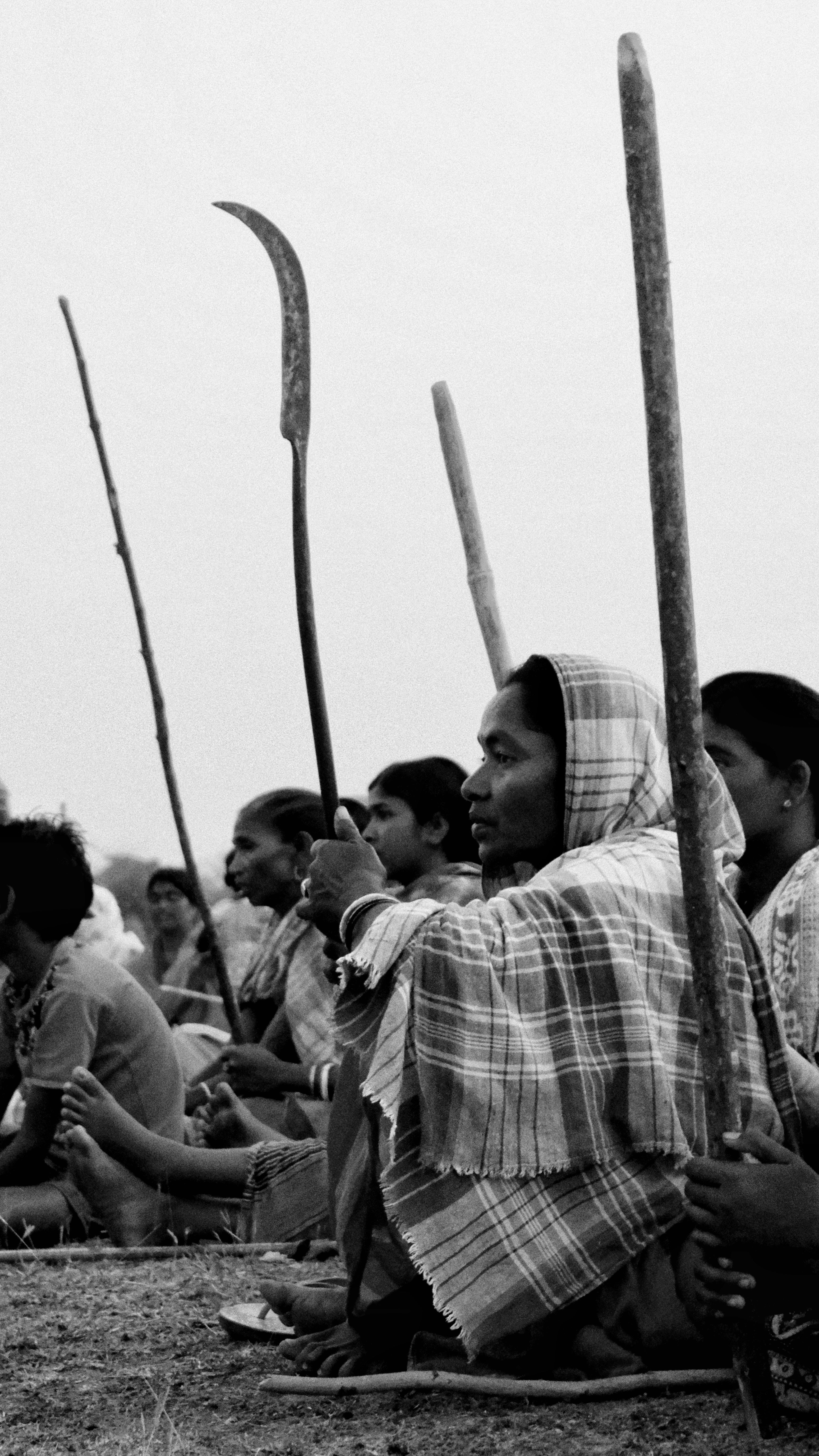
Adivasi women, largely from the Santhal community, are at the forefront of resistance

With bow and arrow: “We vow to protect our land-language-culture and the forest rights”

Villagers register their anger against the land mafias; burning their effigies
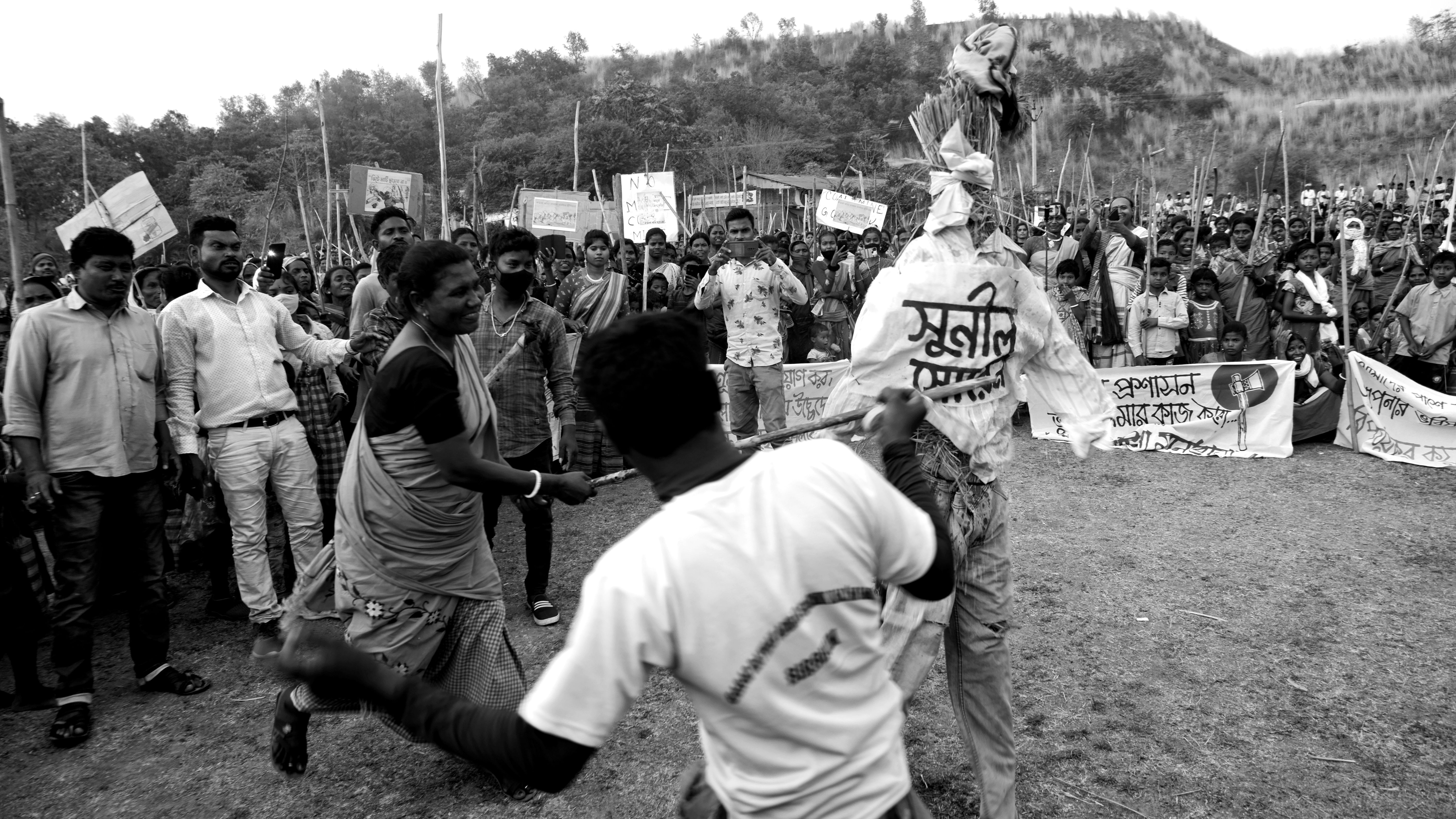
Villagers register their anger against the land mafias; burning their effigies
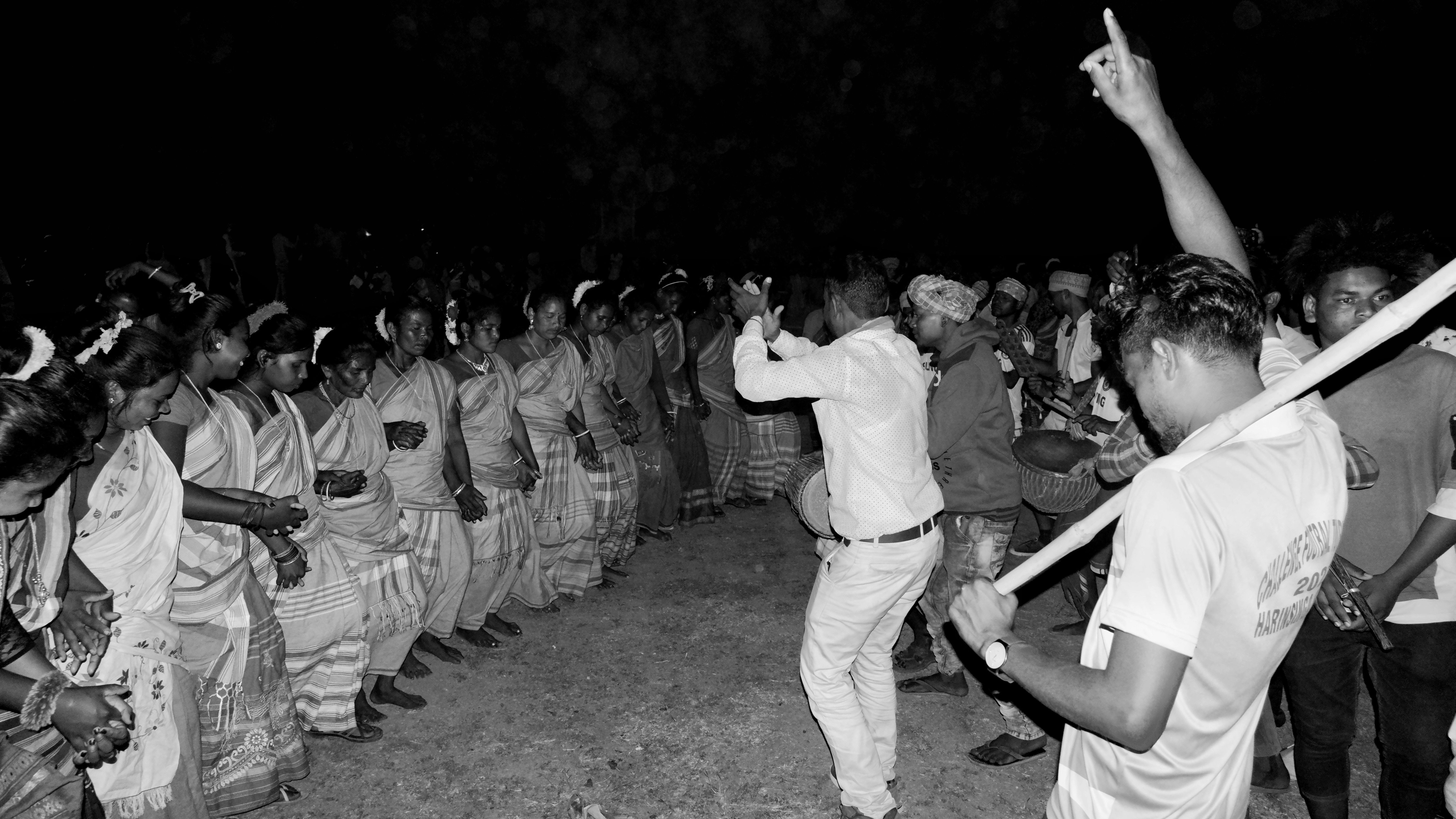
Traditional dance becomes part of the community’s resistance

A community dinner at the common kitchen after a day-long protest
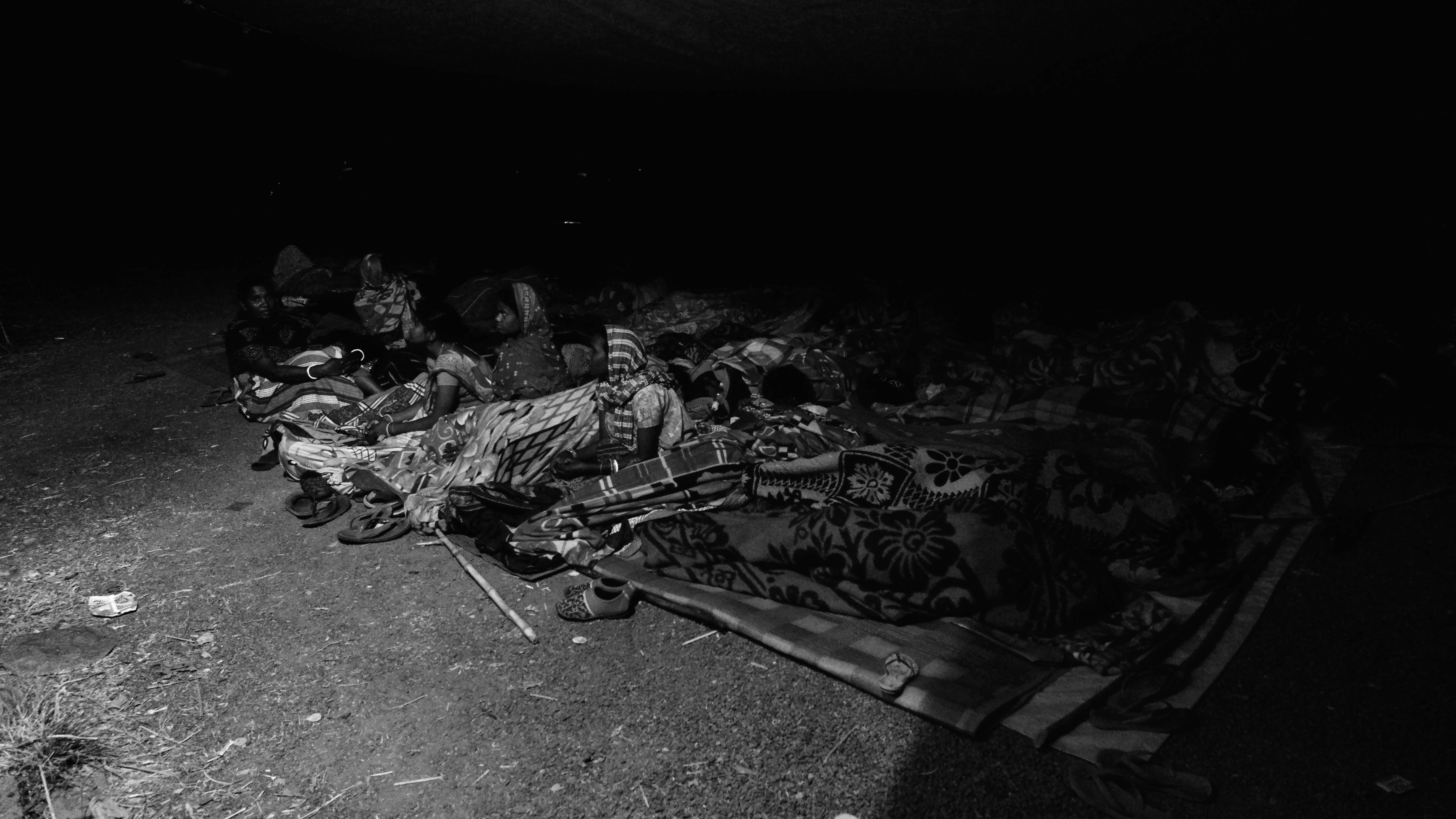
The activists of Birbhum Jami Jeevan Jibika O Prakriti Bachao Mahasabha resting in the open at night, to continue their protest afresh the next day
Tanmay Das is an independent photojournalist based in Jeoldanga, Habra. He completed graduation in 2016 from Habra Chaitanya Mohabodhi College. He has had a long interest in photography which took a serious turn since 2014, when phases of socio-political and psychological changes and the role of media started becoming evident to him. At present, he is pursuing the lens-based work as an alternative practice in, and a response to, our contemporary times.
Malay Tewari is a 46-year-old Kolkata based activist. He studied physics at Raiganj College, JU and IACS. He is in the Communist Cadre at CPI(ML) Liberation. He has been actively involved in the campaign against DPDH coal mine project.